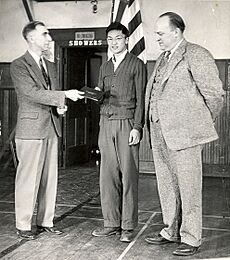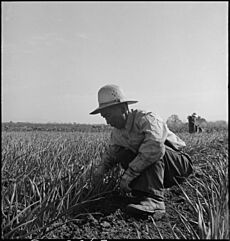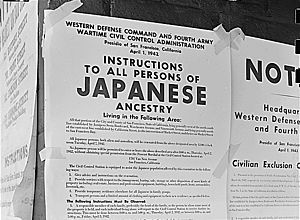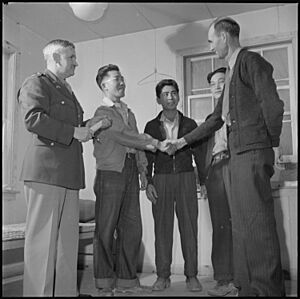History of Japanese Americans facts for kids
Japanese American history tells the story of people of Japanese heritage in the United States. Many people from Japan began moving to the U.S. after big changes in Japan called the Meiji Restoration in 1868. Large groups of Japanese immigrants first came to Hawaii in 1868.
Contents
Early Japanese American History
How Japanese People Came to America
Some of the first Japanese people to reach North America were castaways. For example, Oguri Jukichi arrived in California in 1815, and Otokichi reached Washington state in 1834.
Japan had been mostly closed off from the world. But in 1853, Commodore Matthew Perry from the U.S. visited Japan and helped open it up for trade. This led to direct shipping between San Francisco and Japan by 1855.
Most Japanese people came to the U.S. for better jobs and a new life. Japan was getting crowded, and it was hard to find work. Many young people, especially younger sons who didn't inherit land, looked for chances abroad. In 1870, only 55 Japanese people lived in the U.S., but by 1890, over 2,000 had arrived.
The Chinese Exclusion Act of 1882 stopped Chinese workers from coming to the U.S. This created a need for new workers, and many Japanese people from Hawaii and Japan were hired. Between 1901 and 1908, about 127,000 Japanese people came to the U.S. The number of new arrivals was highest in 1907, with 30,000 immigrants. This was partly because of tough times in Japan after the Russo-Japanese War (1904–1905). Most Japanese immigrants settled on the West Coast, especially in California.
Facing Challenges and Discrimination
As more Japanese people arrived, some Americans became worried. They feared the success of Japanese farmers and worried about a "yellow peril". This led to unfair laws and feelings against Japanese immigrants.
In 1907, President Roosevelt made a deal with Japan called the Gentlemen's Agreement of 1907. Japan agreed to stop issuing passports for new workers coming to the U.S. However, Japanese women could still come if they were married to men already living in the U.S. These women were often called "picture brides."
Japanese immigration mostly stopped when the U.S. Congress passed the Immigration Act of 1924. This law banned almost all Japanese people from entering the country.
This ban created clear groups within the Japanese American community:
- Issei: The first generation, who immigrated before 1924.
- Nisei: Their children, who were born in the U.S. after 1924. They were U.S. citizens and often spoke English.
- Sansei: The third generation, born to Nisei parents.
It wasn't until 1952 that the Immigration and Nationality Act of 1952 allowed Japanese immigrants to become U.S. citizens. More Japanese people started immigrating again after the Immigration and Nationality Act of 1965, which removed the old bans.
Japanese Americans and Farming
Japanese Americans played a big part in developing farms in the Western U.S.
Most of the early Japanese immigrants, the Issei, were young men looking for better economic chances. They often took manual labor jobs in railroads, canneries, and logging camps. They worked very hard, hoping to earn enough money to return to Japan.
This hard work helped many Issei become tenant farmers (renting land to farm) quite quickly. By 1909, about 30,000 Japanese workers were farming in California. They were good at farming because it was a respected job in Japan.
Japanese farmers faced many challenges, like bad weather, grasshoppers, and unfair laws such as the California Alien Land Law of 1913. This law stopped Japanese people from owning land. However, the Nisei (second generation) were U.S. citizens, so these laws didn't affect them as much.
Japanese immigrants brought advanced farming knowledge, including how to work with soils, use fertilizers, and improve land with irrigation. This knowledge, combined with their strong work ethic, helped them grow crops on land that was difficult to farm before. By 1941, Japanese Americans were producing about 30-35% of all commercial crops in California. They also played a big role in distributing fruits and vegetables.
The success of Issei farmers grew until 1942, when many lost their farms because of the internment. Even so, Japanese Americans are still involved in farming today, especially in Southern California and Arizona. Their descendants also continue farming in Oregon and Washington.
During World War II, farming was also important in the internment camps. These camps were in harsh places like the Arizona desert and Tule Lake, California. People in the camps grew food for themselves and also some crops for the war effort. Despite tough conditions, these farming programs were successful because of the inmates' farming skills. Many of these farm lands are still used today.
Before World War II, Seattle had a large Japanese community. Many Japanese immigrants helped clear land east of Lake Washington to create small farms. By the 1930s, Japanese people were Seattle's largest non-white group. On the "Eastside" of Seattle, about 90% of farm workers were of Japanese descent. Also, 90% of the produce sold at Seattle's Pike Place Market came from Japanese American farms.
Internment During World War II

During World War II, about 120,000 Japanese Americans and Japanese citizens living in the U.S. were forced to move to ten different camps. Most of these camps were in the Western U.S. This internment was based on their race, not on anything they had done. Families, including children, were kept together. Each person could bring only two suitcases. Each family, no matter its size, was given one room to live in. The camps had fences and armed guards. Most people stayed in the camps until the war ended, then they left to rebuild their lives.
Japanese Americans Serving in World War II
Many Japanese Americans served bravely in the American military during World War II.
Ben Kuroki from Nebraska became a famous Japanese American soldier. He flew 30 missions as a gunner in Europe. When he returned, he was interviewed on radio and spoke publicly. He even volunteered to fly missions over Japan, becoming the only Nisei to do so. He received the Distinguished Service Medal in 2005.
The 442nd Regimental Combat Team and the 100th Infantry Battalion are the most decorated units in U.S. military history. These units were made up of Japanese Americans and fought with great courage in Europe. The 522nd Nisei Field Artillery Battalion was one of the first units to help free prisoners from the Dachau Nazi concentration camp. Daniel Inouye, who later became a Senator from Hawaii, was a veteran of the 442nd. Also, the Military Intelligence Service had Japanese Americans who served in the Pacific.
In 2010, Congress honored the 442nd Regimental Combat Team, the 100th Infantry Battalion, and the 6,000 Japanese Americans in the Military Intelligence Service with the Congressional Gold Medal.
After World War II: Seeking Justice
After the war, Japanese Americans began a campaign for "redress," which means correcting a wrong. They wanted the government to apologize and pay money to those who had been interned.
In 1978, the Japanese American Citizens' League (JACL) asked for three things:
- $25,000 for each person who was interned.
- An official apology from Congress.
- Money to create an educational foundation for Japanese American families.
Eventually, the Civil Liberties Act of 1988 was passed. This law gave reparations (payments) to surviving Japanese Americans who had been interned. It also officially admitted that the internment was a "fundamental violation of basic civil liberties and constitutional rights."
In 2001, the U.S. government decided to preserve the ten internment camp sites as historical landmarks. Places like Manzanar and Tule Lake now stand as reminders that the nation failed to protect its citizens from prejudice.
Important Dates in Japanese American History
- 1587: A young Japanese boy may have been the first Japanese person to land in North America.
- 1815: Japanese castaway Oguri Jukichi reaches California.
- 1834: Otokichi and two other castaways reach Washington state.
- 1841: Five shipwrecked Japanese sailors are rescued by an American ship. One of them, Manjiro Nakahama, goes to school in New England and later helps Commodore Matthew C. Perry.
- 1852: Joseph Heco (Hikozo Hamada), a Japanese castaway, becomes the first Japanese person to become a naturalized American citizen.
- 1869: A group of Japanese people arrive in California and build the Wakamatsu Tea and Silk Farm Colony.
- 1882: The Chinese Exclusion Act is passed, which opens up more jobs for Japanese immigrants.
- 1885: The first official group of Japanese immigrants arrives in Honolulu, Hawaii, to work on sugar plantations.
- 1893: The San Francisco Board of Education tries to separate Japanese American children in schools but stops after protests from Japan.
- 1900s: Japanese immigrants start renting land and sharecropping (sharing crops with landowners).
- 1907: The Gentlemen's Agreement of 1907 limits Japanese immigration.
- 1908: Japanese "picture brides" begin to arrive in the U.S.
- 1913: The California Alien Land Law of 1913 bans Japanese people from buying land.
- 1924: The federal Immigration Act of 1924 bans almost all immigration from Japan.
- 1927: Kinjiro Matsudaira becomes the first Japanese American mayor of a U.S. city (Edmonston, Maryland).
- 1941: Japan attacks Pearl Harbor. Japanese American community leaders are arrested.
- 1942: President Franklin D. Roosevelt signs Executive Order 9066, starting the internment of about 110,000 Japanese Americans.
- 1942: Japanese American soldiers from Hawaii form the 100th Infantry Battalion.
- 1944: Ben Kuroki becomes the only Japanese American in the U.S. Army Air Forces to serve in combat in both Europe and the Pacific.
- 1944: The 442nd Regimental Combat Team, made of Japanese Americans, merges with the 100th Battalion.
- 1945: The 522nd Field Artillery Battalion (a Nisei unit) helps free prisoners from Dachau satellite camps.
- 1945: The 442nd Regimental Combat Team becomes the most decorated military unit in U.S. history.
- 1952: The Immigration and Nationality Act of 1952 allows Issei (first-generation immigrants) to become U.S. citizens.
- 1957: Miyoshi Umeki wins an Academy Award for Best Supporting Actress.
- 1959: Daniel K. Inouye becomes the first Japanese American to serve in Congress.
- 1962: Minoru Yamasaki is chosen to design the World Trade Center.
- 1965: Patsy T. Mink becomes the first woman of color in Congress.
- 1971: Norman Y. Mineta becomes the first Asian American mayor of a major U.S. city (San Jose, California).
- 1974: George R. Ariyoshi becomes the first elected Japanese American governor (in Hawaii).
- 1978: Ellison S. Onizuka becomes the first Asian American astronaut.
- 1980: Congress creates a commission to investigate the internment during World War II.
- 1983: The commission reports that internment was not needed for military reasons and was based on "race prejudice." It recommends an apology and payments.
- 1988: President Ronald Reagan signs the Civil Liberties Act of 1988, apologizing for the internment and providing $20,000 to each survivor.
- 1992: The Japanese American National Museum opens in Los Angeles.
- 1992: Kristi Yamaguchi wins an Olympic gold medal in figure skating.
- 1999: Eric Shinseki becomes the first Asian American to be chief of staff of a branch of the armed forces.
- 2000: Norman Y. Mineta becomes the first Asian American appointed to the U.S. Cabinet.
- 2010: Daniel K. Inouye becomes the highest-ranking Asian American politician in U.S. history.
- 2011: The Nisei Soldiers of World War II Congressional Gold Medal is awarded to honor Japanese American soldiers.
- 2018: The Supreme Court effectively rejects the 1944 decision that had supported the internment.
See also
- History of Asian Americans
- History of Japan
- Japanese diaspora






